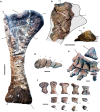A gigantic new dinosaur from Argentina and the evolution of the sauropod hind foot
- PMID: 26777391
- PMCID: PMC4725985
- DOI: 10.1038/srep19165
A gigantic new dinosaur from Argentina and the evolution of the sauropod hind foot
Abstract
Titanosauria is an exceptionally diverse, globally-distributed clade of sauropod dinosaurs that includes the largest known land animals. Knowledge of titanosaurian pedal structure is critical to understanding the stance and locomotion of these enormous herbivores and, by extension, gigantic terrestrial vertebrates as a whole. However, completely preserved pedes are extremely rare among Titanosauria, especially as regards the truly giant members of the group. Here we describe Notocolossus gonzalezparejasi gen. et sp. nov. from the Upper Cretaceous of Mendoza Province, Argentina. With a powerfully-constructed humerus 1.76 m in length, Notocolossus is one of the largest known dinosaurs. Furthermore, the complete pes of the new taxon exhibits a strikingly compact, homogeneous metatarsus--seemingly adapted for bearing extraordinary weight--and truncated unguals, morphologies that are otherwise unknown in Sauropoda. The pes underwent a near-progressive reduction in the number of phalanges along the line to derived titanosaurs, eventually resulting in the reduced hind foot of these sauropods.
Conflict of interest statement
The authors declare no competing financial interests.
Figures





References
-
- Curry Rogers K. Titanosauria: a phylogenetic overview in The sauropods: evolution and paleobiology (eds Curry Rogers K. & Wilson J. A. ) Ch. 2, 50–103 (University of California Press, 2005).
-
- Wilson J. A. An overview of titanosaur evolution and phylogeny in Actas de las III Jornadas Internacionales sobre Paleontología de Dinosaurios y su Entorno (ed Colectivo Arqueológico-Paleontológico de Salas) 169–190 (Colectivo Arqueológico-Paleontológico de Salas de los Infantes, 2006).
-
- González Riga B. J. Paleobiology of South American titanosaurs in Paleontología y dinosaurios desde América Latina (eds Calvo J., Porfiri J., González Riga B. J. & Dos Santos D. ) 125–141 (Universidad Nacional de Cuyo, 2011).
-
- Bonaparte J. F. & Coria R. A. Un nuevo y gigantesco saurópodo titanosaurio de la Formación Río Limay (Albiano–Cenomaniano) de la Provincia del Neuquén, Argentina. Ameghiniana 30, 271–282 (1993).
Publication types
MeSH terms
LinkOut - more resources
Full Text Sources
Other Literature Sources

